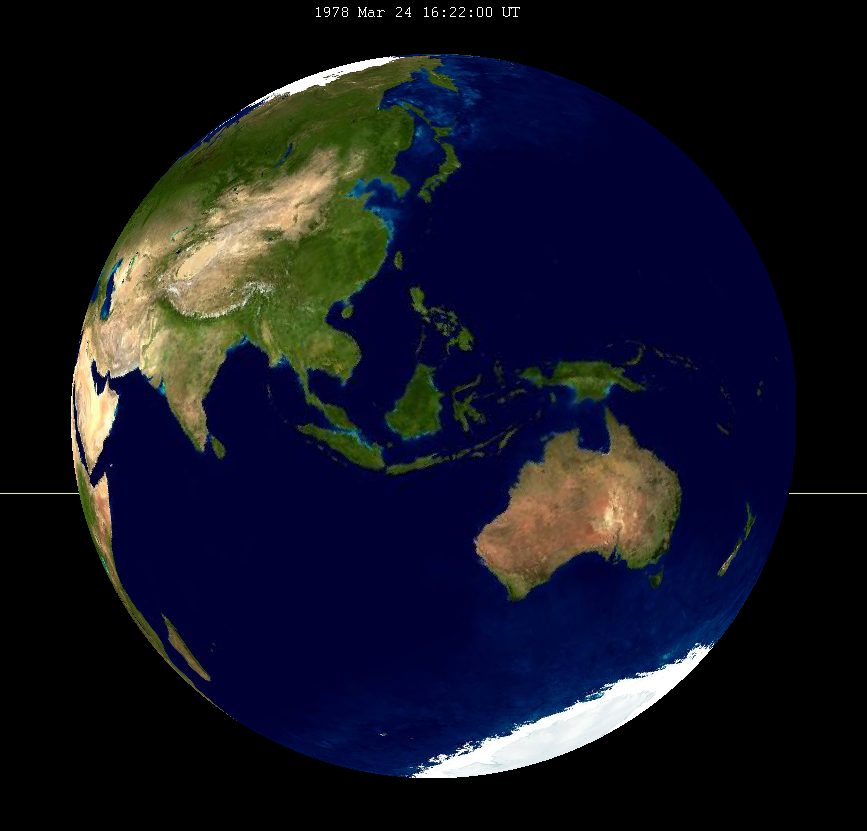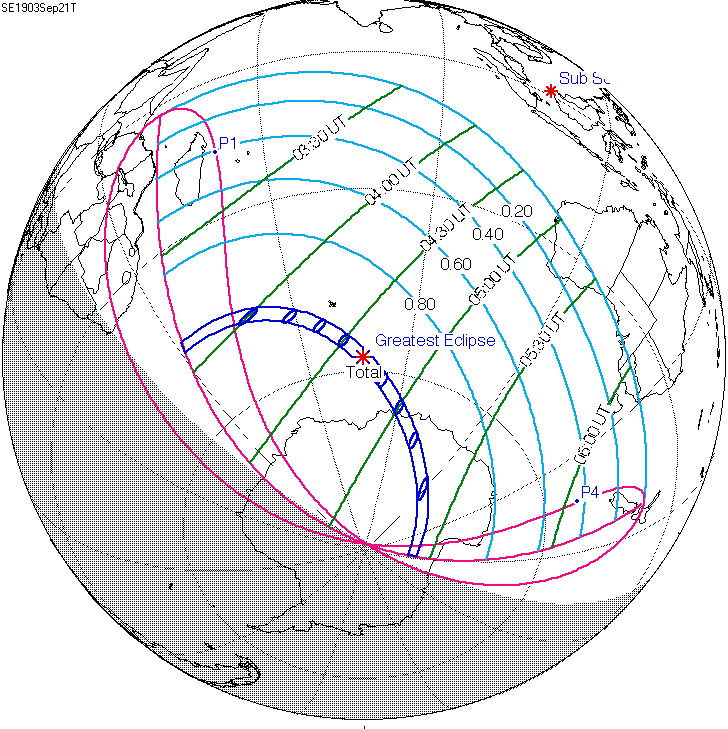|
March 1978 Lunar Eclipse
A total lunar eclipse took place on Friday, March 24, 1978, the first of two total lunar eclipses in 1978. The moon passed through the center of the Earth's shadow. The Moon was plunged into darkness for 1 hour, 30 minutes and 40.2 seconds, in a deep total eclipse which saw the Moon 45.179% of its diameter inside the Earth's umbral shadow. The visual effect of this depends on the state of the Earth's atmosphere, but the Moon may have been stained a deep red colour. The partial eclipse lasted for 3 hours, 38 minutes and 34.5 seconds in total. This is the 54th member of Lunar Saros 122. The previous event is the March 1960 lunar eclipse. The next event is the April 1996 lunar eclipse. Visibility It was seen completely over Asia and Australia, and rising over Africa and Europe. It was seen setting over Pacific Ocean on the morning of Friday 24 March, 1978. Related lunar eclipses Eclipses in 1978 * A total lunar eclipse on Friday, 24 March 1978. * A partial solar eclipse ... [...More Info...] [...Related Items...] OR: [Wikipedia] [Google] [Baidu] |
Lunar Eclipse
A lunar eclipse occurs when the Moon moves into the Earth's shadow. Such alignment occurs during an eclipse season, approximately every six months, during the full moon phase, when the Moon's orbital plane is closest to the plane of the Earth's orbit. This can occur only when the Sun, Earth, and Moon are exactly or very closely aligned (in syzygy) with Earth between the other two, which can happen only on the night of a full moon when the Moon is near either lunar node. The type and length of a lunar eclipse depend on the Moon's proximity to the lunar node. When the moon is totally eclipsed by the Earth, it takes on a reddish color that is caused by the planet when it completely blocks direct sunlight from reaching the Moon surface, as only the light reflected from the lunar surface has been refracted by Earth's atmosphere. This light appears reddish due to the Rayleigh scattering of blue light, the same reason sunrise and sunsets are more orange than during the day. Un ... [...More Info...] [...Related Items...] OR: [Wikipedia] [Google] [Baidu] |
Solar Eclipse Of March 18, 1969
An annular solar eclipse occurred on March 18, 1969. A solar eclipse occurs when the Moon passes between Earth and the Sun, thereby totally or partly obscuring the image of the Sun for a viewer on Earth. An annular solar eclipse occurs when the Moon's apparent diameter is smaller than the Sun's, blocking most of the Sun's light and causing the Sun to look like an annulus (ring). An annular eclipse appears as a partial eclipse over a region of the Earth thousands of kilometres wide. Annularity was visible from part of Indonesia, and two atolls (Faraulep and Gaferut) in the Trust Territory of the Pacific Islands which belongs to the Federated States of Micronesia The Federated States of Micronesia (; abbreviated FSM) is an island country in Oceania. It consists of four states from west to east, Yap, Chuuk, Pohnpei and Kosraethat are spread across the western Pacific. Together, the states comprise a ... now. Related eclipses Solar eclipses of 1968–1971 Saros 129 ... [...More Info...] [...Related Items...] OR: [Wikipedia] [Google] [Baidu] |
Central Total Lunar Eclipses
Central is an adjective usually referring to being in the center of some place or (mathematical) object. Central may also refer to: Directions and generalised locations * Central Africa, a region in the centre of Africa continent, also known as Middle Africa * Central America, a region in the centre of America continent * Central Asia, a region in the centre of Eurasian continent * Central Australia, a region of the Australian continent * Central Belt, an area in the centre of Scotland * Central Europe, a region of the European continent * Central London, the centre of London * Central Region (other) * Central United States, a region of the United States of America Specific locations Countries * Central African Republic, a country in Africa States and provinces * Blue Nile (state) or Central, a state in Sudan * Central Department, Paraguay * Central Province (Kenya) * Central Province (Papua New Guinea) * Central Province (Solomon Islands) * Central Province, Sri Lank ... [...More Info...] [...Related Items...] OR: [Wikipedia] [Google] [Baidu] |
List Of 20th-century Lunar Eclipses
A total of 229 lunar eclipses took place in the 20th century: 83 penumbral, 65 partial and 81 total. See also: Lists of lunar eclipses, List of 19th-century lunar eclipses and List of 21st-century lunar eclipses List Eclipses from 2001 to 2002 are included on the end to complete the final set. References This list was compiled with data calculated by Fred Espenak of NASA's GSFC. {{DEFAULTSORT:20th-century lunar eclipses Lunar eclipses Lunar eclipses A lunar eclipse occurs when the Moon moves into the Earth's shadow. Such alignment occurs during an eclipse season, approximately every six months, during the full moon phase, when the Moon's orbital plane is closest to the plane of the Earth ... Lunar eclipses by time ... [...More Info...] [...Related Items...] OR: [Wikipedia] [Google] [Baidu] |
List Of Lunar Eclipses
There are several lists of lunar eclipses On the Moon, by the Earth ; Type * List of central lunar eclipses * Total penumbral lunar eclipse ; Classification * List of saros series for lunar eclipses * Tetrad (astronomy) contains lists of tetrads in the late-20th and 21st centuries ; By era * Lunar eclipses by century * Historically significant lunar eclipses Historically significant lunar eclipses are eclipses of the Moon that are mentioned in historical accounts in connection with a significant event. Lunar eclipses are somewhat rare events, although not as rare as solar eclipses, because unlike sol ... On Earth, by the Moon {{DEFAULTSORT:Lunar eclipses ... [...More Info...] [...Related Items...] OR: [Wikipedia] [Google] [Baidu] |
Solar Eclipse Of March 29, 1987
A total solar eclipse occurred at the Moon's ascending node of the orbit on March 29, 1987. It was a hybrid eclipse, with only a small portion of the central path as total, lasting a maximum of only 7.57 seconds. A solar eclipse occurs when the Moon passes between Earth and the Sun, thereby totally or partly obscuring the image of the Sun for a viewer on Earth. An annular solar eclipse occurs when the Moon's apparent diameter is smaller than the Sun's, blocking most of the Sun's light and causing the Sun to look like an Annulus (mathematics), annulus (ring). An annular eclipse appears as a partial eclipse over a region of the Earth thousands of kilometres wide. Totality of this eclipse was not visible on any land, while annularity was visible in southern Argentina, Gabon, Equatorial Guinea, Cameroon, Central African Republic, Sudan (part of the path of annularity crossed today's South Sudan), Ethiopia, Djibouti and Somaliland. Related eclipses Eclipses of 1987 * A hybrid solar ... [...More Info...] [...Related Items...] OR: [Wikipedia] [Google] [Baidu] |
Solar Saros 129
Saros cycle The saros () is a period of exactly 223 synodic months, approximately 6585.3211 days, or 18 years, 10, 11, or 12 days (depending on the number of leap years), and 8 hours, that can be used to predict eclipses of the Sun and Moon. One saros period ... series 129 for solar eclipses occurs at the Moon's ascending node, repeating every 18 years, 11 days, containing 80 events. All eclipses in this series occurs at the Moon's ascending node. This solar saros is linked to Lunar Saros 122. Umbral eclipses Umbral eclipses (annular, total and hybrid) can be further classified as either: 1) Central (two limits), 2) Central (one limit) or 3) Non-Central (one limit). The statistical distribution of these classes in Saros series 129 appears in the following table. Events References * http://eclipse.gsfc.nasa.gov/SEsaros/SEsaros129.html External linksSaros cycle 129 - Information and visualization {{Solar eclipses Solar saros series ... [...More Info...] [...Related Items...] OR: [Wikipedia] [Google] [Baidu] |
List Of Central Lunar Eclipses
A central lunar eclipse is a lunar eclipse in which part of the Moon passes through the center of Earth's shadow. This type of lunar eclipse typically appears darker than other lunar eclipses. It is relatively rare. Central lunar eclipses are always total lunar eclipses and have large umbral eclipse magnitude, long duration and small value of gamma. List of central lunar eclipses 1901–1950 There were 19 central lunar eclipses in this period. 1951–2000 There were 14 central lunar eclipses in this period. 2001–2050 There are 10 central lunar eclipses in this period. 2051–2100 There will be 15 central lunar eclipses in this period. 2101-2150 See also * List of lunar eclipses ** List of 20th-century lunar eclipses ** List of 21st-century lunar eclipses There will be 230 lunar eclipses in the 21st century (2001–2100): 87 penumbral, 58 partial and 85 total. Eclipses are listed in sets by lunar years, repeating every 12 months for each node. ... [...More Info...] [...Related Items...] OR: [Wikipedia] [Google] [Baidu] |
Saros (astronomy)
The saros () is a period of exactly 223 synodic months, approximately 6585.3211 days, or 18 years, 10, 11, or 12 days (depending on the number of leap years), and 8 hours, that can be used to predict eclipses of the Sun and Moon. One saros period after an eclipse, the Sun, Earth, and Moon return to approximately the same relative geometry, a near straight line, and a nearly identical eclipse will occur, in what is referred to as an eclipse cycle. A sar is one half of a saros. A series of eclipses that are separated by one saros is called a ''saros series''. It corresponds to: *6,585.321347 solar days *18.029 years *223 synodic months *241.999 draconic months *18.999 eclipse years (38 eclipse seasons) *238.992 anomalistic months The 19 eclipse years means that if there is a solar eclipse (or lunar eclipse), then after one saros a new moon will take place at the same node of the orbit of the Moon, and under these circumstances another eclipse can occur. History The earliest disco ... [...More Info...] [...Related Items...] OR: [Wikipedia] [Google] [Baidu] |





